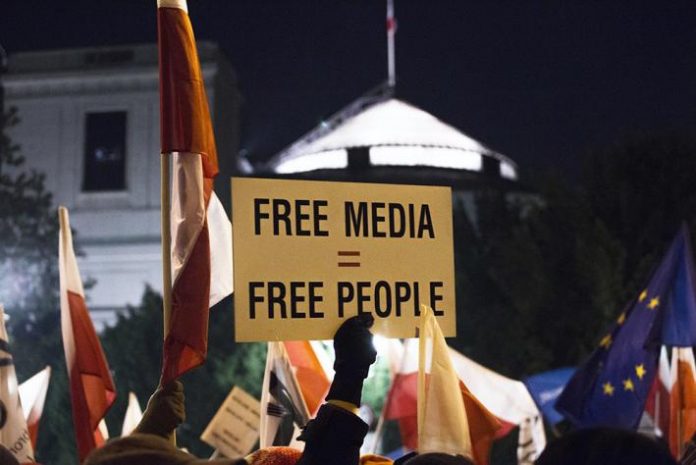This article is written by Ishan Arun Mudbidri from Marathwada Mitra Mandal’s Shankarrao Chavan Law College, Pune. This article talks about the history of the media in Iran.
Table of Contents
Introduction
A recently published report by the Reporters Without Borders mentioned Iran as “one of the world’s most repressive countries”. This means that somewhere Iran is falling behind when it comes to the freedom of expression and freedom of the press. This article gives an overview of the long-standing issue of censorship in Iran.
A brief history of the media in Iran
The Islamic Revolution ended in 1979 and Ayatollah Khomeini became Iran’s Supreme Leader. Before the revolution, Iran was constantly a target to external forces due to its geopolitical location in the Persian Gulf. But, Iran has always shown resistance against foreign interference and emerged as a strong force. During an external invasion, the best way to gain an upper hand and control the enemy is by stopping the flow of information and restricting media coverage, which the Iranian armed forces did. However, even after the revolution, the flow of information remains curtailed. This resistance and constant external pressure somewhere has led to the situation that the press in Iran is facing today. The law of the media in Iran is a combination of stringent Sharia law and Islamic cultural values.
After the revolution, the press underwent rapid development. However, this was for a short time as restrictions were soon imposed on the press in the 1980s. The Ministry of Culture and Islamic Guidance in Iran, imposed a rule to license the publishing agencies. According to this, anyone who wanted to publish had to get a permit. This is where the censorship in Iran started gaining pace. The licenses to the journalists and publishers were given on the condition of not speaking or publishing anything which hurts the sentiments and national interests of the country. This means not criticizing the government. Despite all this, today the media in Iran has grown into a huge community.
Laws and regulations on media in Iran
Constitutional provisions
In 1979, The Constitution of Iran was established, It is based on the Islamic principles and values which are key for the foundation of Iranian society. In this Constitution, freedom of the press and expression is restricted. The Constitution is very strict and has imposed stringent provisions in the context of censorship in Iran. The main draft of the Constitution is said to be written by the Supreme Leader Ayatollah Khomeini, and the provisions mentioned in this Constitution are said to be subordinate to the Ministry of Culture and the Supreme Leader. Article 24 of the Constitution states that the press and publishing agencies have the freedom of expression with certain exceptions to the fundamental principles of Islam or the rights of the public. However, the details of these exceptions are not provided. Further, Article 168 states the conditions for the offences related to the press. It states that the offences related to the press will be tried in front of a jury and the courts of justice, and it will be tried openly.
The Iranian press law
In 1985, the Parliament in Iran approved and passed the Iranian Press law. This law consisted of all the legal procedures, offences of the press, and how the press should function in the Iranian Republican system. Article 1 of the Press law gives the meaning of Press. It states that press consists of publications that are published in a fixed and timely manner, with a fixed name, serial numbers, that consist of information on various fields like news, criticisms, politics, agriculture, military, art, craft, science, and technology, etc. Article 2 of the law, is one of the most important articles in the context of how the Iranian press should function in the country. It states the responsibilities of the press which are:
- Raising the awareness and knowledge of the Iranian public and enlightening them about one or more fields that were mentioned in Article 1.
- Following the aims and objectives mentioned in the Islamic Republic’s Constitution.
- Strive to eliminate false boundaries and not discriminate based on race, language, custom, etc.
- Strengthening the policy of “Neither East nor West”.
Article 6 of the law is also very important and states the limitations on the Iranian press, which are:
- The press is free, except for those publications or articles which weaken Islam’s values and commandments, and the rights of the public.
- Publishing forbidden articles, photographs, and other material that violate public chastity.
- Igniting conflicts between other social layers and creating racial, ethnic issues.
- Exposing confidential information and documents of the Iranian armed forces, and the Islamic Consultative Assembly’s private decisions.
- False charges against Iran’s prominent figures and the legal officers who are respected under the Sharia law.
- Insulting the religion of Islam.
In furtherance to this, the law also states that in certain circumstances, the Supervisory Press Board in Iran has the power to stop the publishing of newspapers and articles and close them down if they are insulting the Supreme Leader and damaging the public morals and values. Hence, the press law forbids the freedom of the press and also imposes harsh punishments on the offenders. In 1999, there was a discussion in the Iranian Parliament to amend the press law and impose further restrictions on the freedom of the press; however, the Parliament has not yet agreed on the proposed amendments. This will make things harder for the Iranian Press.
Freedom of press in the International Law
Now, as we are aware of what the situation has been since the revolution in Iran regarding the freedom of the press. So it is important to know the provisions of international law in the context of censorship and press freedom. The United Nations has always been a strong believer in freedom of speech and expression and considers it a basic human right. One of the UN’s main arms, the UNESCO, promotes freedom of expression which is mentioned in the Universal Declaration of Human Rights.
The UN Declaration of Human Rights, states that freedom of expression is a right that is given to every human being and includes, the freedom to an opinion without any interference, receiving and promoting knowledge and ideas through all forms of the media. UNESCO was established in 1945 and since then it has been the main promoter for freedom of expression and free-flowing ideas. UNESCO does not just promote freedom of expression and information but also helps in giving professional training and guidance to young and aspiring journalists. UNESCO has also provided help in times of conflict in countries like Afghanistan, Libya, Yemen, Nepal, the Middle East, etc. due to such a large-scale response to the importance of press freedom, the UN General Assembly announced 3rd of May, as World Press Freedom Day in 1993.

The International Covenant on Civil and Political Rights, 1976
This Covenant was adopted on 19 December 1966 and came into force on 23rd March 1976. This Covenant binds its parties to respect civil and political rights as well as, the freedom of speech, expression, right to vote, and the right to a free and fair trial.
Article 19 of the Covenant
Article 19 of the international covenant talks about the freedom of expression and information. It states that:
- Every person shall have the right to express his/her opinion without any disturbance or interference.
- Every person shall have the right to freedom of expression which will include, the right to receive information and knowledge and also impart knowledge and ideas of all kinds, irrespective of which country or state he/she belongs to. The flow of information can be in any form: oral, writing, print media, etc.
Other provisions mentioned in the Covenant in the context of freedom of expression
Article 14
Article 14(1) states that every person shall be equal before the law and will have a right to a free and fair trial. Article 14(2) states that every person shall have a right to be innocent before he/she is proved guilty.
Article 2
Clause 3 of Article 2 of the international Covenant states that any person whose rights and freedoms have been violated shall have access to an effective remedy, even though the violation is done by a person who is acting in his/her official capacity.
Current scenario for journalism in Iran
Since the Iranian Revolution, the media in Iran has burst onto the scene. A wide range of print and press is available in Iran, most of them in the capital Tehran. Various TV and radio channels have also increased. Around 95% of the Iranian population watches television and prefers it to read newspapers. There are around 20 to 30 news TV channels and 10 of them are private, covering various political, economic, and international news. The internet and social media also seem to be growing rapidly in Iran and are predicted to be mass media. Despite so much improvement, censorship on the media still exists and is directly watched and controlled by the Supreme Leader.
Instances where freedom of press has been violated in Iran
There have been numerous instances and incidents where the media has been silenced in Iran. Some of them are:
- One of the first instances of censorship in Iran was in 1981 when the revolution was just over and the Supreme Leader Ayatollah Khomeini had taken control. A Persian poet Saeed Sultanpur was arrested and abducted from a wedding ceremony and executed weeks later. The reason was his political and provocative poetry.
- In 2014, an artist by the name of Atena Farghadani had posted a cartoon that showed the Iranian government officials as monkeys and goats. This was in response to a stringent bill regarding birth control in Iran. She was arrested. She later posted a video talking about police brutality on her. She was again arrested and this time, sentenced by the Iranian Court.
- In recent times also, there have been press freedom violations in Iran. A couple of months back, a Bill was proposed in the Iranian Parliament. According to this Bill, the US and British journalists are banned from entering Iran. This Bill was in response to the recent US and British sanctions on Iran.
- In another recent incident, three journalists who were imprisoned were infected with the COVID-19 virus. They were denied appropriate treatment and medical aid.
Iran in the World Press Freedom Index
The not-so-good state of affairs for Iranian journalists was justified by the recent World Press Freedom Index Report.,2020, Iran ranked 173rd out of the total 180 countries in the index. It was also tagged as a repressive country. The report talks about the control over the media, imposing unfair trials, and harassing the journalists. Norway topped the rankings for the fourth consecutive time. Iran has also imposed censorship on the internet, making it a difficult place for journalists and the media fraternity to prosper.
Conclusion
Iran is going through a tough phase in recent times. The US-Iran tensions have led to the US imposing various sanctions on the Islamic Republic. The COVID-19 pandemic has also made an impact in the country. In these times, the already silenced media is going through its most difficult period. The media, although trying to publish its perspectives and opinions on the current scenario, has been tightly controlled. Amidst all this, international support and international pressure seem to be the last hope.
References
- https://www.hrw.org/reports/1999/iran/Iran99o-03.htm
- https://rsf.org/en/news/iran-press-freedom-violations-recounted-real-time-january-2020
- https://www.polygraph.info/a/iran-new-president-and-dubious-claim-of-press-freedom/31338211.html
- https://smallmedia.org.uk/revolutiondecoded/a/RevolutionDecoded_Ch1_MediaLaw.pdf
- https://www.rferl.org/a/iran-tighter-online-censorship-military-control-of-internet/30810346.html
- https://www.article19.org/wp-content/uploads/2017/09/Iran_-Backsliding-on-UN-Free-Expression-Commitments.pdf
- https://www.ohchr.org/en/professionalinterest/pages/ccpr.aspx
LawSikho has created a telegram group for exchanging legal knowledge, referrals, and various opportunities. You can click on this link and join:
https://t.me/joinchat/J_0YrBa4IBSHdpuTfQO_sA
Follow us on Instagram and subscribe to our YouTube channel for more amazing legal content.












